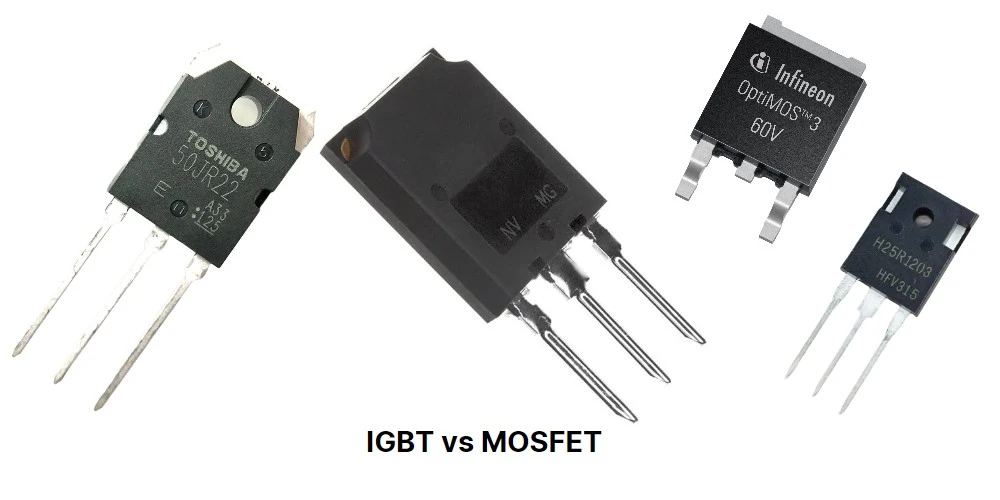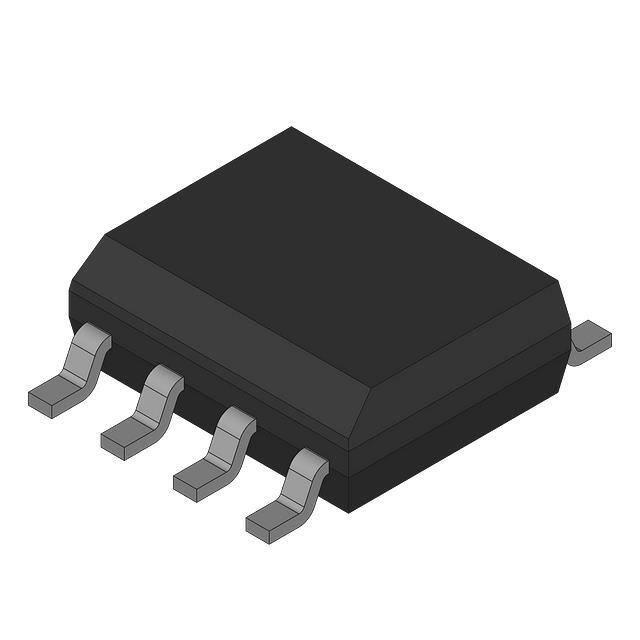IGBT vs. MOSFET: A Comprehensive Comparison of Features
In the world of power electronics, understanding the pros and cons of different semiconductor devices is essential to choosing the right component for your application. The two most commonly used power semiconductors are the insulated gate bipolar transistor (IGBT) and the metal oxide semiconductor field effect transistor (MOSFET). Both are widely used in applications such as motor drives, power inverters, and renewable energy systems, but they each have unique characteristics that make them better suited for specific tasks.
At Dasenic, a leading electronic component distributor, we aim to provide our customers with insights into these two key devices, helping you choose the right components for your electronic system. This article takes a deep dive into the key features of IGBTs and MOSFETs, comparing their advantages and helping you make an informed decision.

What is IGBT (Insulated Gate Bipolar Transistor)
IGBT combines the advantages of MOSFET and BJT (Bipolar Junction Transistor). It has an insulated gate (similar to MOSFET) and can handle larger current and voltage (like BJT). The gate voltage controls the on and off, similar to the working method of MOSFET.
IGBT Advantages:
Able to handle higher voltage and current (usually hundreds of volts to thousands of volts of high voltage, hundreds of amperes of current).
The switching speed is moderate, suitable for medium and high power applications.
Due to its low conduction voltage drop (V_CE(sat)) and high current capability, IGBT is ideal for high power, low frequency applications.
IGBT Disadvantages:
The switching frequency is lower than that of MOSFET, so it is not suitable for very high frequency applications.
It has a large saturation voltage drop (V_CE(sat)) when turned on, which will cause greater energy loss.
IGBT Applications:
High power and high current applications such as power converters, inverters, switching power supplies, frequency converters, electric vehicle drives, rail transportation, etc.
What is MOSFET (Metal Oxide Semiconductor Field Effect Transistor)
MOSFET is a field effect transistor composed of metal, oxide, and semiconductor layers. It uses gate voltage to control conduction and shutdown. It is a type of field effect transistor (FET). It has a very high input impedance and can switch very quickly.
MOSFET Advantages:
The switching speed is very fast, suitable for high-frequency switching applications.
Low switching loss, suitable for high-frequency operation.
High input impedance and low control signal consumption.
Excellent performance in low current and low power applications.
MOSFET Disadvantages:
The voltage that can be tolerated is low (usually tens of volts to hundreds of volts).
It does not perform as well as IGBT in high power and high current applications.
For high voltage loads, the on-resistance of MOSFET is large, which may lead to increased power loss.
MOSFET Applications:
Low power and high frequency applications, such as switching power supplies, power amplifiers, electronic switches, DC-DC converters, etc.
IGBT vs. MOSFET : Key Difference Between
| Characteristic | IGBT | MOSFET |
|---|---|---|
| Working Principle | Combines the features of MOSFET and BJT, controlled by a gate voltage. | Controlled by the gate voltage, which regulates current flow between source and drain. |
| Voltage & Current Handling | Handles higher voltage (hundreds to thousands of volts) and higher current (hundreds of amperes). | Handles lower voltage (typically tens to hundreds of volts) and lower current. |
| Switching Speed | Slower switching speed, suitable for low-frequency applications. | Faster switching speed, suitable for high-frequency applications. |
| Conduction Loss | Higher saturation voltage (V_CE(sat)) leads to higher power loss in conduction. | Lower conduction loss with smaller on-resistance (Rds(on)). |
| Efficiency | Lower efficiency, more suited for low-frequency power applications. | Higher efficiency, well-suited for high-frequency applications. |
| Thermal Performance | Better thermal stability, ideal for high-power applications. | Less thermal stability, typically used in lower power applications. |
| Suitable Frequency Range | Suitable for low-frequency applications (e.g., 50Hz ~ 20kHz). | Suitable for high-frequency applications (e.g., hundreds of kHz or higher). |
| Cost | Relatively higher cost, suitable for high-power applications. | Generally lower cost, ideal for low-power and high-frequency applications. |
When to choose IGBT or MOSFET?
The choice of IGBT or MOSFET depends mainly on the voltage, current, switching frequency and efficiency requirements of the application:
1.High voltage and high current applications:
If you need to handle higher voltages (hundreds of volts to thousands of volts) and larger currents (hundreds of amperes), such as power converters, inverters, and electric vehicle drives, IGBTs are a better choice.
2.High frequency and high efficiency applications:
For high frequency applications (such as switching power supplies, DC-DC converters, etc.) or where the switching loss requirements are low, MOSFETs are more suitable. They have faster switching speeds and lower conduction losses.
3.Medium power applications:
If the power is in the medium range, both IGBTs and MOSFETs can be considered, but the choice needs to be based on the trade-off between switching frequency, efficiency, and cost.
IGBT and MOSFET are both very important power semiconductor devices. The choice of which device depends on the voltage, frequency, power and efficiency requirements of the application.
IGBT is suitable for high-power, low-frequency applications, especially high voltage and high current; while MOSFET is suitable for high-frequency, low-power applications, with higher switching speed and efficiency.
FAQs: IGBT vs. MOSFET
1. What is the maximum voltage of IGBT and MOSFET?
IGBT: Usually can withstand higher voltage, ranging from 300V to 3300V or even higher.
MOSFET: Most MOSFETs are suitable for voltages between 20V and 600V, but some high-end models can also support voltages up to 1000V.
2. What is the maximum switching frequency of IGBT?
A: The maximum switching frequency of IGBT is usually between 20kHz and 50kHz, which is suitable for low-frequency applications.
3. What is the switching frequency of MOSFET?
A: The switching frequency of MOSFET can be very high, reaching hundreds of kHz or even higher, which is suitable for high-frequency applications.
4. Why does IGBT have a large on-state voltage drop?
A: The on-state voltage drop of IGBT is large because its working principle is similar to that of bipolar junction transistor, and it needs to pass through a saturation region to turn on. Although this structure can handle higher current and voltage, it also leads to a larger conduction voltage drop and relatively higher energy loss.
5. How to reduce the switching loss of IGBT?
A: Ways to reduce the switching loss of IGBT include using soft switching technology (such as ZVS or ZCS), optimizing the drive circuit, reducing the switching frequency, etc.
6. Choose IGBT or MOSFET in high-power applications?
A: For high-current and high-voltage applications, IGBT is a better choice, especially in power electronics, inverters and other fields, because it can handle greater power and has better thermal stability.
7. What applications are MOSFET suitable for?
A: MOSFET is mainly used in low-power, high-frequency applications, such as switching power supplies, RF amplifiers, power tools, PC power supplies and other equipment that requires high-speed switching.


